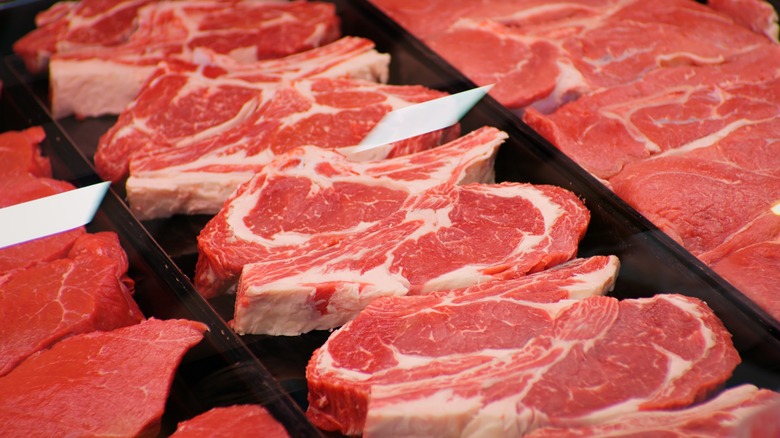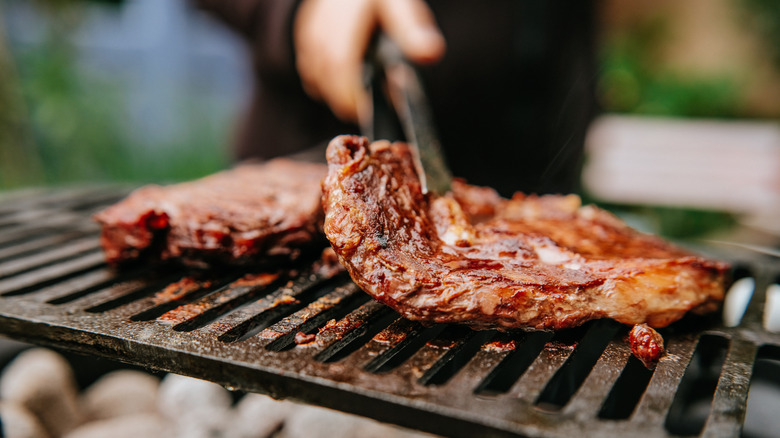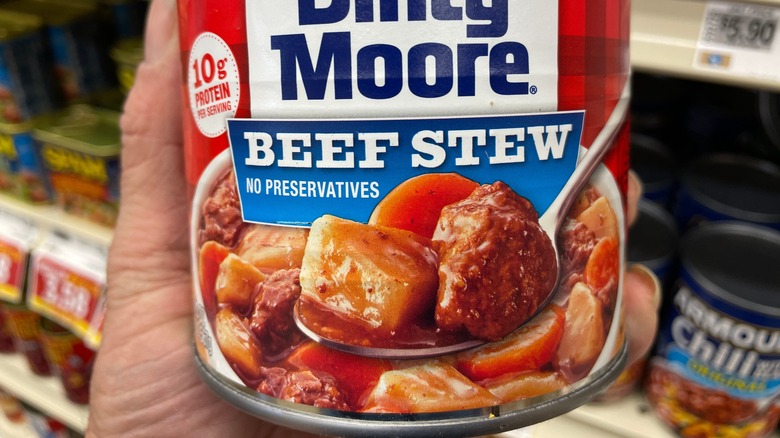The Top Beef Grades And What They Really Mean
If you've ever been shopping for a steak, chances are you've seen different terms or grades used to describe the quality of the meat: Prime, select, and choice are the top ones you'll encounter in settings like supermarkets. These grades are determined by the USDA, and there's eight in total, but the other five are less common. Not all beef is graded — it's a voluntary service that producers have to pay for.
The USDA has two criteria for grading beef. Firstly, how much marbling (that is, fat) the beef has throughout. Since fat tends to add flavor and tenderness, more marbling reflects a higher-quality steak (and correspondingly, a higher grade). The second criterion is the maturity of the cow when it's slaughtered, with younger cattle usually resulting in a higher grade. This is because collagen tends to develop more as cattle age, making meat tougher. An older animal has usually worked out its muscles more, also resulting in tougher meat.
It's important to realize that beef grades are more about quality and taste, rather than nutritional value or food safety. For example, the USDA notes that the protein, vitamin, and mineral contents of beef are similar across all the grades. That said, because a higher-grade cut of beef usually has more marbling, the grades do reflect the fat content to some degree. Prime cuts will have more fat, followed by choice, then select.
What to know about the three top grades
Based on those criteria, the three highest USDA grades for beef are prime (the best and most expensive), followed by choice, and then select at the cheaper end. Price differences inevitably vary depending on the store and cut of beef, but, to use Costco as an example, you can expect prime beef to be around $3 more per pound than choice. Prime beef is a hot commodity, and only about 3% of beef gets this grade. Prime rib nearly always falls within it, as it has plenty of marbling, and is around 8 to 13% fat, making it a reliably juicy and flavorful cut. It's a great option for classic steak cooking methods like grilling or searing, and you'll find it at high-end steakhouses and restaurants.
Choice is the most common grade for beef, with around half of all graded beef fitting this category. Ribeye and sirloin often fit into this grade, with moderate marbling and around 4 to 10% fat content. Choice cuts also work well for dry heat cooking like grilling, as long as you're careful not to dry them out too much, but they can also work for roasting or wet methods like stewing or braising. The select grade tends to feature cuts like chuck, shank, and brisket. With just 2 to 4% fat, it won't be as juicy and tender, so you may need to take steps to tenderize it if you're grilling it, or else save it for stews and braises where it'll soften up.
What about the lower beef grades?
Beyond prime, select, and choice grades, there's actually another five different beef grades: Standard, commercial, utility, cutter, and canner. That said, you're not so likely to encounter these in stores — they're usually ground or processed. The higher of these five grades are standard and commercial. These are sometimes sold without grades on them (in which case they may be marked as "no roll" beef). Alternatively, they may be sold under a supermarket's brand name, also without the grade. Expect these to be cheaper than prime, select, or choice beef, but they're also lower in fat and less tender.
You won't want to throw these on the grill: Consider something stewed like a beef bourguignon, where these tougher cuts will have time to break down and soften up. They're often used for ground meat or sausage although these mixes may be on the leaner side. The bottom three grades likely won't have any marbling at all and will come from older animals, making them pretty tough. They're very uncommon in a grocery store setting, unless it's something like the canner grade beef appearing in pet food. They may also appear in frozen meals, canned soups, or ground beef mixes.


